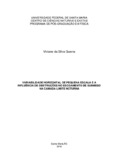| dc.creator | Guerra, Viviane da Silva | |
| dc.date.accessioned | 2019-03-11T18:50:38Z | |
| dc.date.available | 2019-03-11T18:50:38Z | |
| dc.date.issued | 2016-09-30 | |
| dc.identifier.uri | http://repositorio.ufsm.br/handle/1/15868 | |
| dc.description.abstract | The forcings responsible for the spatial variability of mean and turbulent quantities in the nocturnal boundary layer are not well understood, especially when the layer is in a very stable, highly stratified state. Mixing becomes weak and the turbulent eddies are spatially controlled by local features. The variability of mean quantities such as temperature, wind speed and humidity increases and the horizontal transport by non-turbulent modes of the flow, such as submeso, becomes important. In this study, results from two field campaigns, carried out in two distinct sites, are presented. The first experiment happened in moderately complex sites, with many meteorological stations deployed over distances of tens to hundreds of meters. Results show that when the layer is very stable, the variability of mean and turbulent quantities over short distances is triggered mainly by the large-scale mean wind speed. The wind speed value that triggers this transition at a given site depends strongly on the altitude, but also on the proximity to obstructions. The second experiment presents a novel idea. Some stations have been deployed at progressively increasing distances from specific obstacles, such as trees, shrubs or buildings. The aim was to quantify how the different obstacles affect the mean wind speed. To quantify the influence of the obstructions, a transmission factor was determined. From these factors, the decomposition of turbulent kinetic energy into temporal scales through the multiresolution decomposition method allowed determining the effects of the obstacles in different scales of the motion, such as turbulence or non-turbulent low-frequency fluctuations, such as submeso. Results indicate that smaller obstructions, such as trees and small buildings affect more intensely the turbulent scales of the flow, while topographic obstacles have larger impact on longer flow scales. | eng |
| dc.description.sponsorship | Coordenação de Aperfeiçoamento de Pessoal de Nível Superior - CAPES | por |
| dc.language | por | por |
| dc.publisher | Universidade Federal de Santa Maria | por |
| dc.rights | Attribution-NonCommercial-NoDerivatives 4.0 International | * |
| dc.rights.uri | http://creativecommons.org/licenses/by-nc-nd/4.0/ | * |
| dc.subject | Camada limite noturna | por |
| dc.subject | Obstruções | por |
| dc.subject | Variabilidade horizontal | por |
| dc.subject | Submeso | por |
| dc.subject | Nocturnal boundary layer | eng |
| dc.subject | Obstructions | eng |
| dc.subject | Horizontal variability | eng |
| dc.title | Variabilidade horizontal de pequena escala e a influência de obstruções no escoamento de submeso na camada limite noturna | por |
| dc.title.alternative | Small-scale horizontal variability and the influence of obstructions in the flow submeso in the nocturnal boundary layer | eng |
| dc.type | Tese | por |
| dc.description.resumo | Os forçantes que determinam a variabilidade espacial de quantidades médias e turbulentas na camada limite noturna ainda são mal compreendidos, principalmente quando a camada se encontra muito estável, com forte estratificação. A mistura torna-se muito fraca e os turbilhões são controlados espacialmente pelas características locais. A variabilidade entre quantidades médias como, temperatura, umidade e vento local aumenta e o transporte horizontal por modos não turbulentos, como submeso, torna-se importante. Este estudo divide-se em dois experimentos realizados em sítios distintos. O primeiro experimento foi realizado em sítios moderadamente complexos, com várias estações meteorológicas em poucas dezenas ou centenas de metros de distância. Os resultados mostram que quando a camada se encontra muito estável a variabilidade nas quantidades médias e turbulentas entre estações separadas por curtas distâncias é disparada pela velocidade do vento de grande escala. O valor de velocidade do vento que dispara a transição em um determinado local depende fortemente da altitude da estação, mas também da presença de obstruções locais. O segundo experimento apresenta uma proposta inovadora. Algumas estações foram postas próximas e afastadas de obstáculos específicos, como árvores, arbustos e construções, com o objetivo de quantificar como os diferentes obstáculos afetam a velocidade média do vento. Para quantificar os efeitos causados pelas obstruções, um fator de transmissão foi encontrado. A partir desses fatores, a decomposição da energia cinética turbulenta em escalas temporais pelo método da decomposição em multiresolução é possível julgar o efeito da redução causado pelos obstáculos nas diferentes escalas do movimento, como turbulência e escoamento de baixa frequência, ou submeso. Os resultados indicam que obstruções menores, como árvores e pequenas construções afetam mais notadamente as escalas turbulentas do escoamento, enquanto obstáculos topográficos têm maior influência sobre flutuações mais longas do escoamento. | por |
| dc.contributor.advisor1 | Acevedo, Otavio Costa | |
| dc.contributor.advisor1Lattes | http://lattes.cnpq.br/8696858608013659 | por |
| dc.contributor.referee1 | Teichrieb, Claudio Alberto | |
| dc.contributor.referee1Lattes | http://lattes.cnpq.br/9616939649732127 | por |
| dc.contributor.referee2 | Santos, Daniel Michelon dos | |
| dc.contributor.referee2Lattes | http://lattes.cnpq.br/5471637961840087 | por |
| dc.contributor.referee3 | Martins, Luís Gustavo Nogueira | |
| dc.contributor.referee3Lattes | http://lattes.cnpq.br/1434914304135873 | por |
| dc.contributor.referee4 | Medeiros, Luiz Eduardo | |
| dc.contributor.referee4Lattes | http://lattes.cnpq.br/8184054005410712 | por |
| dc.creator.Lattes | http://lattes.cnpq.br/6713904665345676 | por |
| dc.publisher.country | Brasil | por |
| dc.publisher.department | Física | por |
| dc.publisher.initials | UFSM | por |
| dc.publisher.program | Programa de Pós-Graduação em Física | por |
| dc.subject.cnpq | CNPQ::CIENCIAS EXATAS E DA TERRA::FISICA | por |
| dc.publisher.unidade | Centro de Ciências Naturais e Exatas | por |



